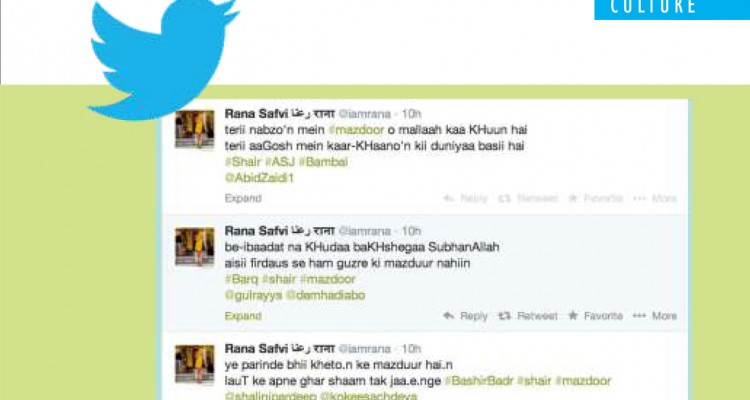Rana Safvi, the cyberspace celebrity with over 10,000 followers on Twitter talks to The Lucknow Observer about her unshakable faith in the Ganga-Jamuni Tehzeeb, about concerns over the outcome of the 16th Lok Sabha elections and the contribution of Hindi films in keeping alive the Urdu language.
Share with us thoughts and feelings of a 21st century Indian Muslim woman like yourself and your deep relationship to your traditions, culture and religion?
As far as I am concerned, religion is private, to be practiced in privacy and between God and me. For me this can be summed up in one verse that those who point fingers at me, why does something concern you that is between me and my god who sees in the soul and not in outer trappings.
arrey logon tumhara kya, mein jaanoon mera khuda jaaney
It is the emergence of religion from our life and into the public space which is responsible for religious fundamentalism in the world.
I am all for preserving traditions and culture but not at the cost of progress. Tradition and progress have to find a way of working hand in hand to keep me wedded to my roots and yet help me move forward.
There is concern bordering almost on paranoia at the thought of a BJP government in Delhi after 16 May…how justified is this concern/paranoia?
Unka jo kaam hai woh ahle siyasat jaane; mera paigham mohabbat hai jahan tak pahunche -Jigar Moradabadi
Politics is their affair, mine is an affair with love for spreading around the world and I have full faith in Indians. If the majority of Indians were not secular and pluralistic, minorities in India would never have survived.
Thanks to social media, the silent majority is no longer silent and is coming out openly and strongly in favor of preserving India’s multi plural society and traditions. It could be a rough ride but it will land safely.
What is a healthy way to thrive as a member of the largest minority community in India without wanting to be appeased or dismissed?
Education and integration, while keeping their identity intact, is the only way ahead. We have to be seen as modern, educated Indians, albeit professing different faith, and not as Muslims, Hindus or Christians.
For those who have no clue how would you explain the Ganga- Jamuni tehzeeb?
India is a civilizational society with its fabric made up of many communities. According to a 1992 survey, there are some 4,634 different communities and through the ages there has been hectic institutional interaction between cultural and social structural elements, of which a unique composite culture is the result. Ganga Jamuni is a term, which describes this uniqueness, this mutually participative co- existence between the two major communities in India. I cannot imagine any other country to have given birth to a genius like Ameer Khusrau, the father of Ganga-Jamuni Tehzeeb, who was just as comfortable in Persian, Arabic as he was in Hindavi, Brij Bhasha and Khari Boli. Which other country has a Sufi saint singing that he will begin playing holi with a bismillah…:
hori khelungi kah bismillah naam nabi ki ratn chadi, boond padi Allah Allah
Which other country has Hasrat Mohani, a Maulana who visited Brindaban after every Hajj as he was a Krishna bhakt. Ganga- Jamuni is when Farid Ayaz sings kanhaiya yaad hai kuch bhi hamari… and Shankar Shambhu sings man kunto maula, both stirring the listener to tears. For me this is Ganga Jamuni tehzeeb, where we are as comfortable saying InshaAllah, MashAllah and Jai Siya Ram in the same breath.
Why is it important to preserve and to practice the Ganga- Jamuni way of life in modern times?
Post 1992 when there were calls of garv se kaho hum Hindu hain and garv se kaho hum Musalman hain, those deeply soaked in Ganga Jamuni tehzeeb had replied garv se kaho hum insaan hain.
With religious fundamentalism growing in our society it is only this syncretic culture, which will guard the idea of India as a multi- cultural, multi-plural country where every Indian is equal.
What are your deepest thoughts during the ongoing 16th Lok Sabha elections?
This has to be the most divisive election in my memory. Though politics is dirty and elections have always sought to exploit vote banks, it is only in this election that the pitch is raised maybe because the stakes for one party are higher. The riots in Muzaffarnagar were labeled as an effort to polarize Western UP prior to Lok Sabha elections to change voting patterns. A natural corollary of this therefore, are hate election speeches of the likes of politicians like Imran Masood, Amit Shah and Azam Khan also booked for fanning communal hatred.
The fallout will be the end of unity and polarization of communities of ordinary people on religious lines.
On the future of Urdu?
Post 1947 it was Hindi films which had lyricists of the highest caliber who kept the tradition of Urdu poetry alive in the public space. Dialogues written in Hindustani (a more colloquial version of Persianised Urdu) was the preferred language of Hindi films and is still today. However, Urdu was on the decline and with Sanskrit being adopted as a third language in Northern India, very few were able to read and write the script. Then came Mehdi Hasan and Jagjit Singh and ghazals became a rage in India. The latter, especially, chose very easy to understand ghazals and once again interest in Urdu was revived. Today, I find that though a very small percentage of Indians can actually read and write Urdu, many appreciate the language, enjoy Urdu shayari and make an effort to understand it.
Urdu is definitely on the rise in Devnagari and Roman script. It is once again being associated with romance and not just a community. I see this daily on twitter where I moderate a very popular forum called #shair where we tweet shayari as per a given schedule. We have members across regions, religions and language divide.
What do you mean when you say my name is Urdu and I am not a muslim?
Kyun mujhko banate ho tassub ka nishana Maine to kabhi khud ko musalmaan nahi maana (Why have you made me a target for bigotry? I have never thought myself a Muslim) After independence, the Sub-Committee on Fundamental Rights recommended that the official language of India be made Hindustani, as it was already the national language: “Hindustani, written either in Devanagari or the Perso-Arabic script at the option of the citizen, shall, as the national language, be the first official language of the Union.” Unfortunately Pakistan adopted Urdu as its national language and this idea was dropped by the Constituent Assembly. The biggest disservice to Urdu was the association of Urdu with a particular community as it was a language born in India and out of the many languages in use here. British encouraged the perception that it was associated with
Muslims. The advent of Printing Press in India cemented this perception as Persianised Urdu was used to print religious texts of Muslim and Sanskritised Hindi was used for Hindu religious texts. Missionaries distributed Bibles in Urdu & Devnagari script, which further cemented the divide. It was late 19th & 20th century onwards only when Urdu became associated with Muslims. Premchand wrote in Urdu script. PM Manmohan Singh writes in Urdu as does Gulzar.
You have created a certain ambience on twitter with your urdu poetry contributions and thousands of followers.
Tell us how that happened and where are you heading in cyber space?
I think #shair was an idea that was waiting to happen given the love for shayari amongst Indians. The ghazal lends itself particularly to twitter as a verse of a ghazal tells a complete story in 140 characters. I get comments from many strangers and friends telling me how much #shair means to them, as it not only provides a break for them from their work but also excessive politics on twitter. I, myself have learnt a lot via this as I had to read and research to answer the questions I get asked. This led to my writing on many of the topics I was asked about.

